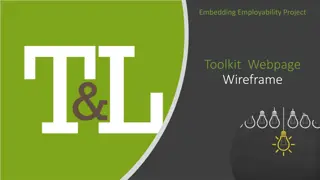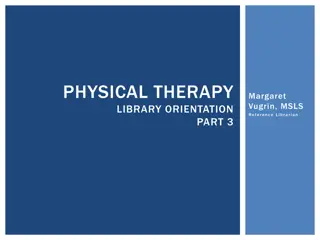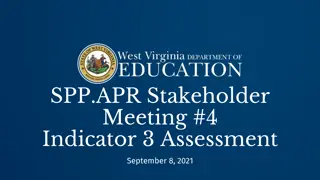Comprehensive Stakeholder Engagement Toolkit Orientation and Practice Session
Engage in a detailed session covering the key features of a Stakeholder Engagement Toolkit, including planning for socio-cultural factors, assessing stakeholder knowledge, and facilitating group discussions. Learn how the Toolkit provides guidance for efficient stakeholder engagement, documentation of engagement strategies, and comparison of best practices across research teams. Understand the importance of ongoing stakeholder engagement as a critical process in research activities.
Download Presentation

Please find below an Image/Link to download the presentation.
The content on the website is provided AS IS for your information and personal use only. It may not be sold, licensed, or shared on other websites without obtaining consent from the author.If you encounter any issues during the download, it is possible that the publisher has removed the file from their server.
You are allowed to download the files provided on this website for personal or commercial use, subject to the condition that they are used lawfully. All files are the property of their respective owners.
The content on the website is provided AS IS for your information and personal use only. It may not be sold, licensed, or shared on other websites without obtaining consent from the author.
E N D
Presentation Transcript
Stakeholder Engagement Toolkit Orientation and Practice Session Insert: Facilitator Name, Title Organizational Affiliation Facilitator Name, Title Organizational Affiliation
Introductions Name Title Study site/location Brief description of the most notable (good/bad) stakeholder engagement activity you were ever involved with
Objectives By the end of this session, participants will be able to: 1. Describe key features and components of the Toolkit, including the E-resources 2. Identify and plan for socio-cultural and other issues/factors that impact research and stakeholder engagement activities 3. Interact with stakeholder groups to: Assess knowledge/perceptions using the Agree/Disagree activity Establish group norms and guidelines Build capacity using role plays Facilitate agreement through group discussion
Introducing the Toolkit s Features and Components
Objectives of the Stakeholder Engagement Toolkit Provide step-by-step guidance to help HIV researchers engage stakeholders efficiently and transparently Provide tools to help staff document their plans and experiences as they implement a stakeholder engagement strategy Make it easier for research teams in different settings to compare methods and identify best practices
Stakeholder Engagement as an Ongoing Process predicting which challenges might arise is difficult resources must be set aside for potential stakeholder engagement activities and to mitigate complications asses and develop knowledge and skills ensure everyone can appropriately and effectively engage with the research and each other research team must be committed and capable deficiencies in capacity for stakeholder engagement must be addressed ensure that accurate information about the trial reaches stakeholders and the broader community combat misperceptions or rumors that may exist determine whether stakeholder engagement efforts are effective and reflective of the time and resources involved identify individuals and organizations with a stake in the project compile/organize relevant information about them in a way that makes sense understand the relationships between stakeholder groups and the context within which the trial takes place prepare accordingly
Adapting the Toolkit for Different Needs Research teams planning to implement their first HIV-related clinical trial at a single site Experienced research teams Multi-site research teams Research networks
How the Toolkit is Organized Each step of the Toolkit contains: Goals/rationale Task list Case studies, tips and quotes Checklist Tools (appendices)
Tools Available Step 5: Identify and describe stakeholders Tool 5A: Stakeholder identification sheet Helps to organize your stakeholder list and ensure activities engage a full range of stakeholders Tool 5B: Stakeholder data collection sheet Tool to collect information about stakeholders you wish to approach Tool 5C: Identification of stakeholder roles Helps to determine which identified stakeholders can fill stakeholder roles that your trial needs Tool 5D: Stakeholder contact record Helps to plan and track initial contact with new stakeholders
Toolkit Quick Guide Electronic document that helps users navigate and use the components of the Toolkit modifiable files of the tools (Word and Excel) expanded instructions
Toolkit Quick Guide: Reference Table Stakeholder Engagement Steps and Tasks Toolkit Tools (Word and Excel files) Step 1. Plan and Budget for Stakeholder Engagement Assess your organization s stakeholder engagement capacity and practices (identify gaps and opportunities for improvement). 1A: Organizational self-assessment 1B: Gaps and opportunities Steps Create a budget for stakeholder engagement activities. 1C: Budget for stakeholder engagement Develop a stakeholder engagement action plan including objectives, activities, staff roles, proposed timeline. 1D: Action plan 1E: Activity prioritization grid Tasks 1F: Matrix of stakeholders (potential roles) 1G: Work plan Tools Word or Excel files 1H: Timeline Develop standard operating procedures (SOPs) for stakeholder engagement staff. 1I: Sample job descriptions Step 2. Secure Commitments to Guiding Principles Obtain buy-in for stakeholder engagement activities from other research team members. 2A: Action planning guide 2B: Stakeholder engagement commitment sheet Step 3. Design a Monitoring and Evaluation System Develop measures to track stakeholder engagement program progress. Step 4. Describe Key Features of the Research Context 3A: Indicator examples (There are no Toolkit tools for this step.) Identify ways in which political, cultural, economic and climate issues impact research planning, implementation.
Quick Guide: Expanded Instructions for Select Tasks Develop measures to track stakeholder engagement program progress (Step 3) Develop and maintain a stakeholder databank (Step 5) Assess knowledge and skills to determine how to build capabilities (Step 7)
Identifying and Planning for Socio-cultural and Other Factors that Impact Research and Stakeholder Engagement Activities
Discussion Question What are some of the socio-cultural and other factors that might impact the research or stakeholder engagement activities? What impact might these have?
Benefits of Identifying and Planning for Socio-cultural Factors Facilitates identification of stakeholders that need to be engaged Improves understanding of the relationships and networks that link stakeholders Facilitates communication of the research concept Improves understanding of the relationship between local, national and regional contexts Enables development of a research project that is well-adapted to the broad context
Small Group Activity Read the description of the Study Design. Two options: US-based study (HPTN 073) Africa-based study (HPTN 071) Use your own experience and conditions in your study site to answer the Sociocultural Landscape question selected by your small group. Discuss similarities/differences between the sites represented in your small group. Summarize your groups responses on a flipchart to share with the entire group.
Interacting with Stakeholder Groups to: Assess Knowledge/Perceptions Using the Agree/Disagree Activity
Reflection Recall an instance when you assumed that a close friend or colleague thought like you did about a particular issue but discovered they did not. What was the effect of your misperception ? No! Yes?
Do you Agree? Or Disagree? All HIV prevention studies must comply with the Good Participatory Practices (GPP) guidelines. Condoms prevent pregnancy and STI transmission. Adolescents should have access to contraceptives. ART should be available to all people infected with HIV. HIV testing should be mandatory for pregnant women. Participants should have the approval of their spouses/partners prior to study enrollment.
Interacting with Stakeholder Groups to: Establish Group Norms and Guidelines
Reflection Think about positive experiences that you had in other group settings. What was it about that group that made it successful?
Discussion Questions Why it is important to establish group norms? in general? for groups that are meeting for the first time and have long-term goals that they want to accomplish as a team? for groups who may only meet once but have very diverse opinions and backgrounds?
Why establish norms/guidelines for stakeholder groups? Guides the behavior of group members to ensure goals can be met Specifies expectations for interpersonal interactions and other communications Ensures that all members own the norms Enables members to call each other out on dysfunctional behavior that negatively impacts group
Interacting with Stakeholder Groups to: Build Capacity Using Role Plays
Reflection Think about how you have used role plays or experiences where you participated in role plays. What was it about the role play that made it effective or memorable? How was the role play activity configured?
Building Capacity with Scripted Role Plays and Checklists Clarify expectations about best practices to follow when completing the task/skill Provide a method for giving structured feedback to participants Assess participants ability to perform the task/skill Skills Checklist
Interacting with Stakeholder Groups to: Facilitate Agreement through Group Discussion
Preparing for and Conducting Role Plays Watch the demonstration role play Decide in your group who will play which character Read the background materials: General instructions for each role Scenario and/or specific instructions for your character Guidelines for giving and receiving feedback Conduct the role play Give each other feedback Debrief with the other small groups
Post Role Play Discussion Questions for Small Groups Self-assessment Participant Perspective Objective Feedback What did the CLO facilitator do in this situation that was most effective? What might the CLO facilitator consider doing differently? Did the CLO facilitator complete the steps and meet the standards for the items included on the Role Play Observation Checklist?
Role Play Discussion Questions While playing the role of the CLO facilitator While playing the role of the stakeholder meeting participant While playing the role of the observer
Please tell us what you think Use your green and red dots to VOTE! MOST BENEFICIAL LEAST BENEFICIAL
Copies of the Toolkit Limited print copies of the Stakeholder Engagement Toolkit for HIV Prevention Trials are available by request (publications@fhi360.org) includes a CD with the 2014 Toolkit Quick Guide and additional resources Access a web version of the Toolkit Quick Guide at www.fhi360.org























